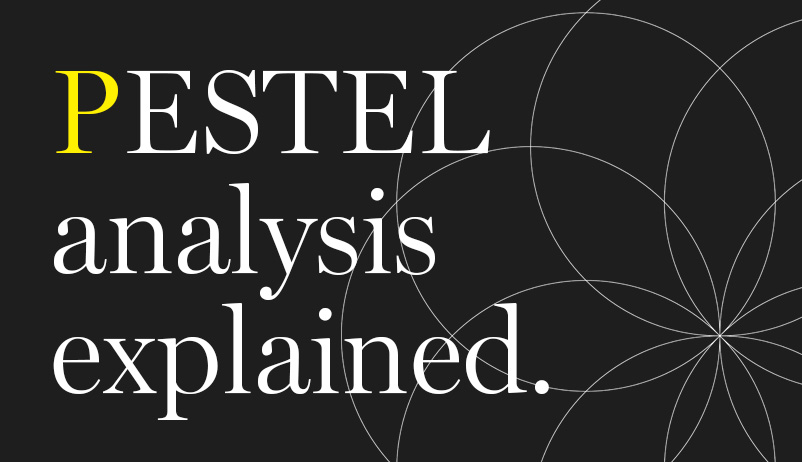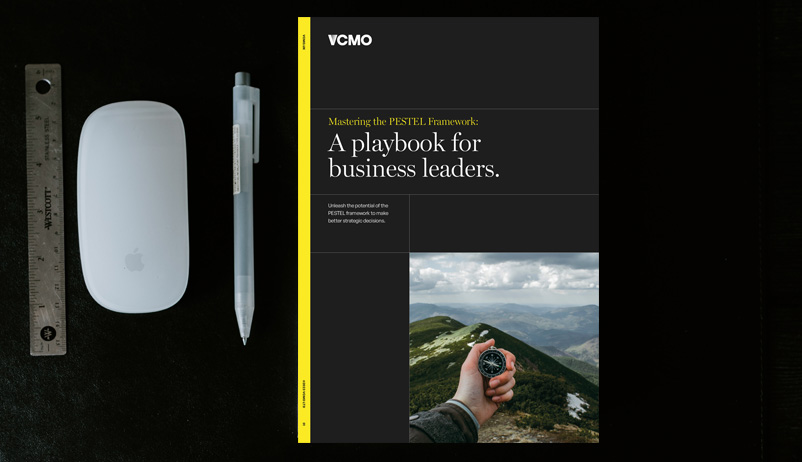

PESTEL Analysis
PESTEL Analysis
What is a PESTEL Analysis?
Lorem ipsum dolor sit amet, consectetur adipiscing elit. Suspendisse varius enim in eros elementum tristique. Duis cursus, mi quis viverra ornare, eros dolor interdum nulla, ut commodo diam libero vitae erat. Aenean faucibus nibh et justo cursus id rutrum lorem imperdiet. Nunc ut sem vitae risus tristique posuere.
What Does a PESTEL Analysis Mean in Marketing?
In marketing, a PESTEL analysis is a strategic framework used to analyse and identify the macro-environmental factors that affect a business or industry. The acronym PESTEL stands for Political, Economic, Social, Technological, Environmental, and Legal.
What Are the Six Elements of PESTEL?
Here is a summary of each of the six components of the PESTEL framework:
- Political factors refer to the impact of government regulations, policies, and political stability on a business. This includes things like taxation, trade policies, and government stability.
- Economic factors include the overall health of the economy, inflation rates, interest rates, and the availability of credit. These factors can have a significant impact on a business's operations and financial performance.
- Social factors look at the cultural and social environment in which a business operates, including demographic trends, lifestyle changes, and consumer behavior. This helps businesses understand consumer preferences, needs, and trends.
- Technological factors refer to the impact of new and emerging technologies on a business, including changes in automation, the internet, and mobile technology. These factors can provide new opportunities for businesses to innovate and streamline their operations.
- Environmental factors include the impact of environmental issues on a business, such as climate change, sustainability, and waste management. This is particularly important for businesses in industries that are particularly resource-intensive or have significant environmental impact.
- Legal factors refer to the impact of laws and regulations on a business. This includes everything from employment law to health and safety regulations to intellectual property law.
What’s the Difference Between PESTLE and SWOT Analysis?
PESTLE analysis and SWOT analysis are both strategic planning tools used to assess the external and internal factors affecting a business. PESTLE focuses on the external macro-environmental factors, highlighted above, to identify opportunities and risks.
SWOT, on the other hand, assesses a business's internal strengths and weaknesses, as well as external opportunities and threats. While PESTLE provides a broader view of the external factors, SWOT is more focused on the internal aspects of a business. PESTLE helps identify external influences, while SWOT helps assess a business's internal capabilities and competitive position in light of external factors.
Both analyses are valuable for strategic decision-making and planning and can work together alongside other frameworks such as Porter’s Five Forces, 4Ps, and the Business Model Canvas to name but a few.
An Example of a PESTEL Analysis
Here's an example of a PESTEL analysis for a fictional company that manufactures and sells smartphones. For each element some key factors have been identified that could help the company make the right strategic decisions:
Political Factors
- Government regulations and policies related to the telecommunications industry, such as spectrum allocation, import/export regulations, and trade agreements.
- Political stability and geopolitical risks in key markets, which can affect the company's supply chain and operations.
- Taxation policies and incentives that impact the company's production costs, pricing strategy, and profitability.
Economic Factors
- Economic conditions, such as GDP growth, inflation, exchange rates, and interest rates, which can affect consumer purchasing power, demand for smartphones, and the company's sales and revenue.
- Economic disparities and income distribution, which can impact the affordability and demand for smartphones in different markets.
- Economic policies and trends, such as trade policies, economic sanctions, and economic cycles, which can affect the company's global market access and business operations.
Social Factors
- Demographic factors, such as population size, age distribution, and cultural norms, which can impact consumer preferences, purchasing behaviour, and demand for smartphones.
- Social attitudes and trends towards technology, smartphones, and sustainability, which can affect the company's brand image, customer perception, and market positioning.
- Social issues, such as privacy concerns, ethical concerns related to labour practices or environmental impact, which can influence consumer perception and purchase decisions.
Technological Factors
- Technological advancements in the smartphone industry, such as 5G technology, artificial intelligence, and augmented reality, which can impact the company's product development, competitive advantage, and market positioning.
- Intellectual property rights, patents, and technological standards, which can affect the company's innovation capabilities, product differentiation, and market access.
- Technological infrastructure and digital readiness in different markets, which can impact the company's distribution channels, online sales, and customer engagement.
Environmental Factors
- Environmental regulations and standards related to manufacturing, packaging, and waste disposal, which can impact the company's operations, supply chain, and sustainability efforts.
- Environmental concerns and consumer preferences towards eco-friendly products, recyclability, and environmental impact, which can influence consumer purchasing decisions and brand perception.
- Climate change risks and natural disasters, which can impact the company's supply chain, manufacturing facilities, and business continuity.
Legal Factors
- Legal regulations and compliance requirements related to product safety, intellectual property, consumer protection, and data privacy, which can impact the company's operations, product development, and customer trust.
- Legal disputes, litigation, and regulatory fines, which can impact the company's reputation, financial performance, and brand image.
- Changes in legal frameworks, policies, and regulations, such as antitrust, competition, or trade laws, which can affect the company's market access, business practices, and competitive landscape.
This is just an example of a PESTEL analysis, and the actual factors to consider may vary depending on the industry, company, and specific circumstances. It's important to conduct a comprehensive and customised analysis to identify the relevant external factors that may impact a business's operations, opportunities, and risks.

"PESTEL analysis is a strategic framework that comprehensively assesses the external factors impacting a business, aiding in strategic decision-making, resource allocation, and competitive positioning. Yet very few businesses use this framework when developing the over-arching business plan. Apply it in the right way and use it in conjunction with other frameworks to build a business strategy that can fast-track you to greater success."
Paul Mills
Founder, VCMO
What Are the Advantages of PESTEL Analysis?
Conducting a PESTEL analysis helps business leaders to understand the external factors that may impact their operations and industry. Some of the benefits that a PESTEL analysis provides are:
- Comprehensive Assessment of External Factors: PESTEL analysis considers a wide range of external factors providing a comprehensive view of the business environment. This allows organisations to identify opportunities and risks associated with various external factors.
- Strategic Planning and Decision-making: PESTEL analysis helps organisations in strategic planning and decision-making by providing insights into the external factors that may impact their business operations, market positioning, and overall success. It enables organisations to align their marketing strategy with the external environment.
- Early identification of opportunities and risks: PESTEL analysis helps organisations proactively identify potential opportunities and risks arising from changes in the external environment. This allows businesses to take timely actions, capitalise on opportunities, and mitigate risks effectively.
- Better Resource Allocation: PESTEL analysis helps organisations prioritise their resources by identifying the most relevant and impactful external factors. It allows businesses to allocate their resources, such as time, budget, and effort, efficiently and effectively based on the identified opportunities and risks.
- Improved Competitive Positioning: PESTEL analysis helps organisations understand the external factors that influence the competitive landscape, enabling them to make informed decisions on how to position themselves in the market. This can lead to a more competitive positioning by leveraging opportunities and mitigating risks, thereby enhancing the overall competitiveness of the organisation.
What Are the Disadvantages of PESTEL Analysis?
It’s worth noting that there are some disadvantages of conducting a PESTEL analysis, these include:
- Overwhelming Amount of Information: PESTEL analysis requires gathering and analysing data on various external factors, which can result in a large amount of information that may be overwhelming to process and prioritise.
- Limited Focus: PESTEL analysis primarily focuses on external factors, which may not fully capture the internal strengths and weaknesses of an organization, as well as the specific nuances of its industry or market.
- Lack of Specificity: PESTEL analysis provides a broad overview of the external environment, but may not provide specific insights or actionable recommendations that are tailored to the organisation's unique situation.
- Changing and Uncertain Factors: The six external factors analysed in PESTEL analysis are subject to change and may be uncertain, making it difficult to accurately predict their impact on the organisation.
- Limited Depth: PESTEL analysis may only provide a surface-level analysis of external factors, and may not delve deeply into the underlying complexities and dynamics of each factor, potentially resulting in oversimplification or overlooking of critical factors.

Free Download: A Guide to Mastering the PESTEL Marketing Framework
We have published a marketing guide providing a user-friendly introduction to the PESTEL strategic framework, with practical insights on how to apply it in your business strategy.
Click this link to access the guide.
Recap on PESTEL Analysis.
In conclusion, PESTEL analysis is an important tool for businesses to assess several external factors that may impact their operations and industry. By considering these factors, businesses can better anticipate changes, reduce risks, and identify new opportunities for growth and success.
However, it's important to note that PESTEL analysis should be used as a tool in conjunction with other strategic planning and analysis methods to obtain a comprehensive understanding of the business environment.
About VCMO
VCMO is a UK-based provider of fractional marketing services, supporting B2B SMEs—ranging from funded scale-ups to mid-tier and private equity-backed businesses—through key moments of growth and transformation. Its Chartered Fractional CMOs and SOSTAC® certified planners embed strategic marketing leadership into organisations navigating product launches, new market entry, acquisitions, and leadership gaps.
Ready to take your marketing to the next level? Let us help you get there.
Subscribe to Our Newsletter
Fractional Edge is our montly newsletter sharing expert opinion on the latest trends in fractional leadership, curated marketing content from leading sources, VCMO events, and much more. Subscribing is quick — just add your name and email.








